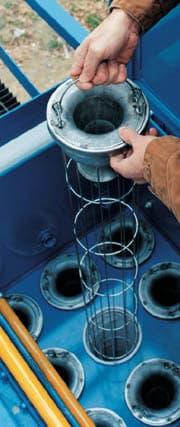At Sly, part of our mission is helping our customers focus on what they do best – running their business profitably – while we guide them toward the most efficient and cost-effective pollution control solutions for their specific needs. To further this mission, we’ve just added two new capabilities to our list of client services: baghouse bag analysis and particle size analysis.
Filter Bag Failure Analysis Services

Replacing filter bags is among the most significant operating expenses for a baghouse system. However, compromising on filter quality to get a lower price is almost invariably a poor decision over the lifetime of a system. Symptoms of underperforming bags include high-pressure drop, an increase in resistance to flow, poor mechanical characteristics, and unacceptable particulate emissions.
By analyzing baghouse filters that have failed in use, then combining those lab findings with your operating data, Sly can diagnose the source of your problem and recommend the appropriate corrective action, such as an alternative bag type that’s better suited to your dust’s particle size, chemistry, operating conditions, etc. Improving the performance of your filter media in terms of lower emissions, higher airflow, and reductions in lost production due to unscheduled downtime can also help you gain better control over your total system operating cost.
Sly’s filter bag failure analysis services consider the five modes of filter failure: mechanical strength/wear, chemical degradation, thermal degradation, dust penetration/media blinding, and incorrect design. The bag tests performed include:
- Permeability Testing: Permeability is the volumetric flow rate, measured in cubic feet per minute (cfm), through a square foot of filter media at a pressure differential of 0.5” water gauge (w.g.).
- Mullen Burst Strength Test: This is a measure of the two-dimensional, or planar, strength of the media, measured in pounds per square inch.
- Tensile Strength Test: This is a measure of the directional strength of the media, measured in pounds per square inch.
- Microscopy: A light microscope is often used to supplement the visual analysis of a filter sample to determine the particulate interactions with the filter surface. Cross section microscopic photographs are used to analyze dust penetration into the media.
Here’s an example of the report we produce on your filter bag failure analysis.
Filter Bag Failure Analysis – Sample Report
Particle Analysis Services
Understanding the characteristics of the dust being filtered starts with a measurement of bulk density and particle size distribution.
- Bulk density is a weight per unit volume measurement, which is expressed in grams per cubic centimeter or in pounds per cubic foot. The object of the analysis is to determine the bulk or apparent density of dust. This data can then be used for the diagnosis of re-entrainment or aid in fabric filter design.
- The particle size distribution test is used to determine the range of particle sizes present in a dust sample. The results are presented in terms of particle size versus the cumulative percentage of total weight or volume. When plotted on a log-probability graph, the mass-mean diameter can be determined. This is a characteristic parameter of the dust that can be used to predict filter performance in applications where similar dusts are being used.
Here’s an example of the report we will produce for your particle size analysis.
Particle Size Analysis – Sample Report
Sly has produced a series of informative videos that can help you optimize the performance of your dust collector or baghouse, which you can view through our website. We suggest you may want to start with the Start-Up Procedure for a Dust Collector or Bag House video.

